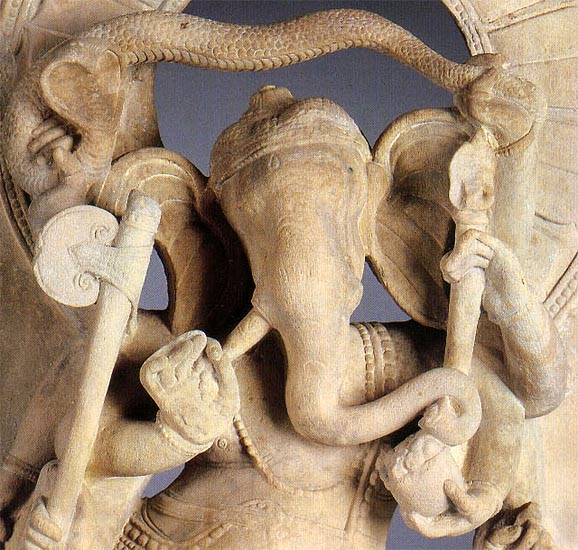
Dancing Ganesha
India (Uttar Pradesh), 9th-10th century
Beige sandstone, 29 1/2 in (74.9 cm)
Published: Ray 1986, pp. 188 and 190-91, fig. 2
| Such steles with images of dancing Ganesha are usually placed in niches
on the south walls of temples, where they are the first major images that
devotees view as they begin their clockwise circumambulation. This placement
is appropriate for a divinity who is regarded as the god of beginnings
and is to be invoked before undertaking any task. This role has assured
Ganesha's popularity with all Hindus, and even the Jains and the Buddhists
worship him. Ganesha also has his own small shrines in most large temple
complexes, but dancing images of the god are generally meant for external
walls. Clearly, Ganesha dances in imitation of his father Shiva, who is considered to be the supreme teacher of the performing arts as well as the cosmic dancer. Even if profound philosophical import is not attached to Ganesha's dance, certainly he appears to have been a popular figure in the iconographic scheme, especially of Shaiva temples. Both the variety and complexity of his dancing images are also noteworthy compared to the repertoire of his more celebrated father. Both aesthetically and technically, Ganesha's feat, considering his bulk, is no less laudatory and admirable than Shiva's. In this perfectly preserved and deeply cut relief, the dancing god is portrayed with eight hands, the two above his head holding a snake like a trophy, mimicking his father's dance of victory, when Shiva upholds the flayed hide of the elephant titan Gajasura in a similar fashion. One almost sees a Freudian touch here as the elephant-headed one (gajanana) upholds the serpent, which is a prominent symbol of his father. Among his other visible attributes are a battleaxe and a trident, both of which he usurps from his father. The lower-left hand holds a bowl of sweets, which he loves to eat, explaining his ample girth. Nimble footed, he dances to the rhythmic sound of two drummers on either side. A half lotus is carved on the base, and a large lotus halo sets off this head. Much of the stele behind the dancing god has been completely cut away, allowing the viewer to appreciate better the three-dimensional volume and buoyancy of the form, with its multiple arms, bulky body, and elephant's head with large fan-like ears. Indeed, it is his elephantine form and his boyish nature that perhaps make Ganesha's dance an example of cavorting rather than of cosmic activity, although some poets and theological texts extolling his glory do emphasize the latter aspect. all
text and images © The Trustees of the Walters Art Gallery, Baltimore
|
